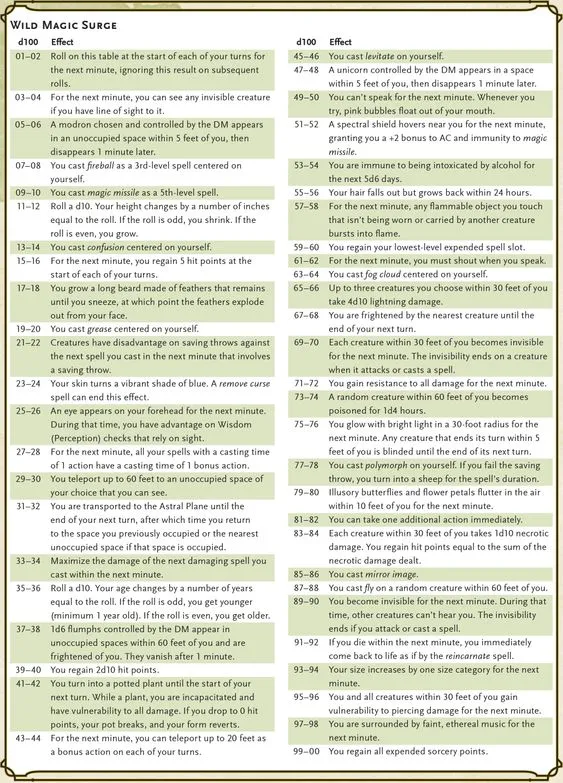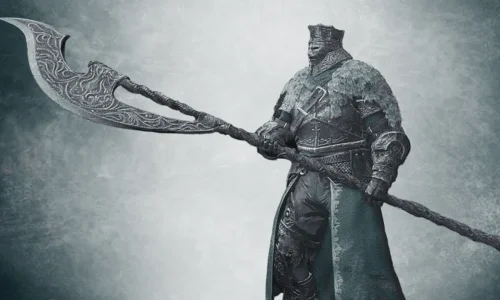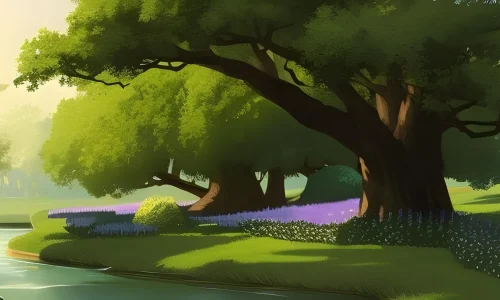Wild magic is a unique and exciting aspect of Dungeons & Dragons 5th edition gameplay that can add unpredictability and fun to any campaign. At the heart of wild magic lies the Wild Magic Table, a comprehensive list of potential magical effects that can occur when a spellcaster triggers a surge of wild magic.
Understanding the table and its various effects is essential for both players and dungeon masters, as it can greatly impact gameplay and character development. In this article, we will delve into the history of wild magic in D&D, explore the Wild Magic Table in detail, and examine its advantages and disadvantages for gameplay.
Wild Magic Table in D&D 5e

We will also provide tips and ideas for incorporating wild magic into campaigns and offer guidance on roleplaying with wild magic. Whether you are a seasoned player or a new dungeon master, this article will provide valuable insights and resources for exploring the exciting world of wild magic in D&D 5e.
Origins of wild magic D&D
In the world of Dungeons and Dragons (D&D), wild magic is a type of magic that is unpredictable and can have unexpected effects. The origins of wild magic in D&D can be traced back to the early editions of the game, specifically the 1st edition of the Advanced Dungeons & Dragons (AD&D) rulebooks.
In the AD&D rulebooks, wild magic was introduced as a result of a character’s exposure to powerful and unpredictable magical energies. The idea was that when a character was exposed to these energies, they could potentially trigger a surge of wild magic, which could have a variety of effects, ranging from harmless to dangerous.
Over the years, the concept of wild magic has evolved and been expanded upon in subsequent editions of D&D. In the 5th edition of D&D, for example, there is a specific subclass called the Wild Magic Sorcerer, which focuses on harnessing and controlling wild magic in a more intentional way.
Overall, the origins of wild magic in D&D can be traced back to the game’s early days, and the concept has continued to be a popular and intriguing aspect of the game for players and dungeon masters alike.
History of Wild Magic D&D
Wild magic has been a part of Dungeons & Dragons since the game’s early days, although its specific manifestations have evolved over time. The concept of wild magic can be traced back to the original D&D supplement, Eldritch Wizardry, which introduced the idea of “wild magic zones” that could cause spells to misfire or produce unexpected results.
wild magic was further developed and expanded in this edition of the game. In 2nd edition, for example, several spells had a chance of triggering a wild magic surge, while in 3rd edition there were specific prestige classes and feats focused on wild magic. However, it was in the 5th edition that wild magic truly came into its own, with the inclusion of the Wild Magic Table as a core mechanic.
How to roleplay wild magic
Roleplaying wild magic can be a lot of fun and adds an element of unpredictability to your character’s actions. Tips to roleplay wild magic is given below
Embrace the chaos: Wild magic is unpredictable, so don’t be afraid to let your character act impulsively or erratically. You can add some flavor to your roleplay by describing how your character’s magic manifests in unexpected ways.
React to the outcome: When you use wild magic, make sure you react to the outcome of your roll. If your magic surges out of control, describe how your character reacts to the unexpected effect of their spell.
Incorporate backstory: If your character has a backstory that involves wild magic, you can use that to inform your roleplay. Maybe your character has a history of accidentally causing chaos, or maybe they are scared of their own powers.
Collaborate with your DM: Your DM can help you incorporate wild magic into the game and provide guidance on when to use it. Work with them to make sure your use of wild magic fits with the world and the story.
Explanation of each entry in the table and its effects
The Wild Magic Table in Dungeons & Dragons 5th edition can add an element of unpredictability and excitement to gameplay, especially when used in conjunction with a wild magic sorcerer character. You need to keep in mind some steps while using Wild Magic Table in gameplay:
Carefully activate a Wild Magic Surge: Whenever a wild magic sorcerer casts a sorcerer spell of 1st level or higher, have them roll a d20 immediately afterward. If they roll a 1, trigger a Wild Magic Surge and have them roll on the Wild Magic Table.
Consult the Wild Magic Table: Have the wild magic sorcerer roll a d100 to determine which effect on the Wild Magic Table is triggered. Consult the list of effects and apply the appropriate one to the game.
Adjust the game accordingly: Depending on the effect triggered, the DM may need to adjust the game. For example, if a fireball is cast centered on the sorcerer, the DM may need to determine who is caught in the blast and apply damage accordingly. Alternatively, if the sorcerer grows a beard made of feathers, the DM may decide that it attracts the attention of birds or other creatures.
Consider using the Wild Magic Table creatively: The effects on the Wild Magic Table can be used to add flavor to gameplay and inspire creative solutions to challenges. For example, if the sorcerer gains the ability to see invisible creatures, it could help the party spot hidden enemies or solve a puzzle that involves invisible ink. The effects can also be used to inject humor into the game, such as when the sorcerer’s skin turns a vibrant shade of blue.
How to use the Wild Magic Table 5e table in gameplay
The 5e Wild Magic Table includes a wide range of effects, from minor annoyances to powerful boons, and can be triggered by a number of different events, such as casting a spell or rolling a natural 1 on a spell attack. This makes wild magic a highly unpredictable and exciting aspect of gameplay and has made it a favorite of many players and dungeon masters alike. Overall, the evolution of wild magic in D&D demonstrates the game’s commitment to innovation and creativity and ensures that players always have new and exciting challenges to face.
What is the Wild Magic Surge Table?
The Wild Magic Surge Table is a table of 50 effects that can occur when a wild magic sorcerer in Dungeons & Dragons 5th edition rolls a “wild magic surge” after casting a spell. The effects range from cosmetic changes to the caster’s appearance or surroundings to random spellcasting effects that can have a significant impact on gameplay. It adds an element of unpredictability and chaos to gameplay, making it an exciting feature for players and dungeon masters alike.
Roll Effect
1 All creatures within 30 feet of you take 2d10 force damage.
2 you can transport yourself within a range of 60 feet to a vacant place which is in your sight.
3 You regain 2d10 hit points.
4 For the next minute you are cloaked with a magic spell so nobody can see you.
5 A appears in an unoccupied space within 5 feet of you, then disappears 1 minute later.
6 You can have the ability to cast a fireball spell on yourself.
7 You can have the ability to take one action immediately.
8 you have a choice to teleport yourself in a radius of 20 feet as a bonus.
9 Roll a d10. Your level of length changes by a number of inches equal to the roll. You grow or get smaller depending on the dice if it’s even you will become taller and vice versa
10 you can have the ability to cast a magic missile of level 5
11 You can reclaim your bottommost-level consumed spell slot.
12 you have a beard made with a light feathers it will remain with you until you sneeze.
13 Cast a confusion centered on yourself.
14 you are obliged to shout when you speak in the next minute.
15 You cast Fog Cloud centered on yourself.
16 You regain your spent sorcery points.
17 You can cause one creature of your choice within 60 feet of you to become poisoned for 1d4 hours.
18 You grow a pair of wings for the next minute, allowing you to fly at a speed of 60 feet.
19 You regain all expended spell slots.
20 You suffer no effect from the wild magic surge, but your eyes glow with arcane energy for the next minute.
21 your hair will decrease but it will regain its strength in upcoming 24 hours
22 you are encircled in a place with dim ghostly music for one minute.
23 You regain 1d10 expended spell slots, but they are all randomly chosen from among the spell slots you have already used.
24 you are turned into a plant until your next turn. While a plant you have a vulnerability to all damage but you are invulnerable to venom and ailment.
25 If you expire within a couple of minutes, you immediately come back to life as if by the Reincarnate spell.
26 Your skin turns into an exciting shade of navy. An Eliminate Curse spell can terminate this consequence.
27 There is an eye on your forehead in a couple of minutes. You have an advantage on Insight checks that depend on your third eye vision.
28 In the following minute, you can transport yourself up to 20 feet to a vacant space. It is a bonus action of yours for each turn.
29 You cast a Misunderstanding spell on an arbitrary creature within a reach of 60 feet of you.
30 you are protected from all damages in the following minute.
Note that this table is just one example of wild magic surge effects and can be modified or replaced to fit the needs of your game. Additionally, the exact effects of wild magic surges may vary depending on the rules of the game or the specific source of the wild magic.
31 Your mouth becomes a portal to another plane of existence. Roll a d100. A result of 1-60 sends you to a harmless plane. A result of 61-100 sends you to a plane of the DM’s choice.
32 You are walled by a supernatural shield that lasts for a couple of minutes. It gives you invulnerability to Magic Missile. giving way you a +2 bonus to AC.
33 You can reclaim 2d10 sorcery points.
34 All mortals within a range of 30 feet of you gain vulnerability to piercing damage for the next minute.
35 You are terrified by the next-door creature unless your turn ends
36 You can use a floating spell on yourself.
37 you are unable to speak for a minute. If you try to speak glowing bubbles drift out of your mouth.
38 You are immune to damage from spells for the next minute.
39 Your sight is hazy and you have a hindrance on the attack for the next minute.
40 petals and Butterflies will dance in your surrounding within 10 feet of you.
41 you can transport yourself within a range of 60 feet to some vacant space which is in your sight.
42 You regain 1d6 expended levels of spells, but you cannot cast spells of that level for the next minute.
43 Until the end of your next turn you have the ability to turn yourself into a venomous frog or giant.
44 you can see any cloaked creature for the next minute.
45 You regain 2d10 hit points and gain a flying speed of 30 feet for the next minute.
46 You cast Darkness centered on yourself.
47 You can’t be surprised for the next minute, regardless of whether you are conscious or asleep.
48 You are invulnerable to liquor for the next five to six days.
49 Your voice booms like thunder for the next minute, audible within 300 feet of you.
50 You cast Polymorph on yourself.
51 You summon an uncontrollable swarm of butterflies that lasts for the next minute, distracting everyone within 10 feet of you.
52 You are teleported to a random location within 500 feet of your current location.
53 you can utilize a third-level fireball spell on yourself.
54 You regain 1d4 expended levels of spells, but you cannot cast spells of that level for the next minute.
55 You are cloaked with a magical spell so nobody can see you for next minute.
56 you can have a smooth feathered beard until you sneeze.
57 You are immune to damage from the next spell that targets you within the next minute.
58 You cast the Fog spell to save yourself from the sight of others.
59 You are transformed into a sheep for the next minute.
60 Your arms turn into tentacles until the end of your next turn, giving you a reach of 15 feet with your unarmed strikes.
61 You cast Invisibility on yourself as a 2nd-level spell.
62 You cast Confusion centered on yourself.
63 you have a vulnerability to all damage for the next minute. You possess 2d10 hit points.
64 For the next minute you are in an utterly quite place.
65 You are transformed into a penguin for the next minute.
66 You cast Light centered on yourself as a 3rd-level spell.
67 You are immune to being charmed or frightened for the next minute.
68 You cast Mirror Image on yourself.
69 You are transformed into a giant sloth for the next minute.
70 You used a level three thunder wave spell around you.
71 You become invisible for the next minute, but any noise you make still remains audible.
72 You are transformed into a cactus for the next minute.
73 You cast Detect Thoughts on yourself.
74 You are surrounded by a hailstorm of rock-hard popcorn that pings off your armor and equipment harmlessly for the next minute.
75 You are transformed into a swarm of rats that lasts for the next minute.
76 Within a range of 60 feet you utilize polymorph on an unknown creature.
77 You grow an extra arm for the next minute.
78 you can float on an unknown mortal within sixty feet.
79 you are converted into a tiny potted plant until your next turn ends.
80 You cast Fly on yourself.
81 You are transformed into a giant badger for the next minute.
82 You regain 2d10 expended spell slots.
83 You cast Haste on yourself.
84 You are surrounded by a swarm of buzzing flies for the next minute.
85 You cast Charm Person on yourself.
86 You are transformed into a giant goat for the next minute.
87 You cast Slow centered on yourself.
88 You are surrounded by a field of wild magic that persists for the next minute.
89 You are transformed into a tiny, harmless fish for the next minute.
90 You use a stinking cloud centered on yourself.
91 You are transformed into a giant eagle for the next minute.
92 You cast Darkness centered on yourself as a 2nd-level spell.
93 You are surrounded by a rainstorm that only affects you for the next minute.
94 You cast Polymorph on yourself, but you cannot revert back to your original form for the next minute.
95 You are transformed into a baby elephant for the next minute.
96 within a range of 60 feet you use a confusion centered on a random mortal creature.
97 You regain 4d10 hit points, but you suffer from a random disease for the next week.
98 You are transformed into a tree for the next minute.
99 You cast Fire Storm as a 7th-level spell centered on yourself.
100 You are transformed into a powerful creature of the DM’s choice. Roll a d100. On a 51-100, you become a creature that is hostile to you.
Which effects in the Wild Magic Table 5e are most harmful?
Roll Effect
14 A fireball explodes with you at the center
23 You cast confusion centered on yourself
33 You take 1d10 necrotic damage per level of the spell you just cast
40 your appearance turns into dark blue color. In order to end this effect, you need to cast a remove curse spell.
42 you can use level five magic missile.
45 You can teleport up to 70 feet to a vacant space of your choice that you can see
50 You will be cloaked for the next minute. Nobody can hear you. Invisibility will end if you attack or cast any magical spell on a creature.
51 Your body becomes semi-transparent until the end of your next turn. You are invulnerable to damage for one minute.
61 You get scared by the neighboring creature until the end of your next turn
73 For the next minute you are invulnerable to all kinds of damages.
79 Within a range of 30 feet you and all creatures get piercing damage for the next minute
88 until the end of your next turn you get terrified by your neighboring creature.
92 you get psychic harm. It is mandatory to use a teleport spell so you can transport within a range of 60 feet.
95 You are surrounded by an anti-magic field in a 10-foot radius for the next minute
Which effects in the Wild Magic Table cast spells?
There are several effects on the Wild Magic Table in D&D 5e that involve casting spells, either as a result of a wild magic surge or as a prerequisite for the effect.
Effect 3: “You diffuse a level three fireball spell centered on yourself.”
Effect 8: “You emit a confusion spell centered on yourself.”
Effect 10: “you can radiate level five magical missile.”
Effect 13: “You cast mirror image.”
Effect 23: “You can use a floating spell on yourself.”
Effect 29: “In a range of sixty feet you fly on any random creature.” It’s important for players and dungeon masters to be familiar with the entire table, as it can have a significant impact on gameplay and character development.
Pros and Cons of Wild Magic?
Wild magic, also known as chaotic magic, is a type of magic that involves a certain degree of randomness and unpredictability.
Pros:
Surprise factor: Wild magic can catch your opponents off-guard as they won’t be able to predict what you’re going to do next.
Versatility: Wild magic can have a wide range of effects, from damaging spells to healing spells, making it a versatile option for a variety of situations.
Fun and excitement: Wild magic can add an element of unpredictability and excitement to gameplay, making it a popular choice for role-playing games.
Cons:
Unpredictability: While unpredictability can be an advantage, it can also be a disadvantage, as wild magic can sometimes backfire and harm the caster or their allies.
Lack of control: The caster of wild magic spells often has little control over the outcome of their spell, which can be frustrating if they were hoping for a specific result.
Risky: Wild magic is often seen as a high-risk, high-reward option, as the potential for both positive and negative outcomes is high.
Overall, wild magic can be a thrilling and exciting option for those who are willing to take risks and embrace unpredictability.
Which effects in the Wild Magic Table summon creatures?
None of the effects on the Wild Magic Table in Dungeons & Dragons 5th edition specifically summon creatures. However, some effects can indirectly lead to the summoning of creatures.
For example, Effect 45 on the Wild Magic Table states: “you and all creatures in a radius of 30 feet get intense damage for one minute.” This effect could potentially cause enemies or other creatures to take advantage of the vulnerability and attack the party, leading to a combat encounter that could involve summoned creatures.
Effect 50 on the Wild Magic Table states: “For the next five to six days you are invincible to alcohol, so you can’t get drunk during that time.” This effect could potentially lead to the party visiting a tavern or other establishment where they encounter NPCs who have had too much to drink and cause trouble, possibly leading to a combat encounter that involves summoned creatures.
It doesn’t have any effects that directly summon creatures, some effects can indirectly lead to situations where summoned creatures might be encountered.
Benefits of using wild magic in gameplay
Using wild magic in Dungeons & Dragons gameplay can have several benefits for both players and dungeon masters. Adds unpredictability and excitement:
- One of the main benefits of using wild magic in gameplay is that it can add a sense of unpredictability and excitement to encounters. Since the effects of wild magic are random and can range from minor cosmetic changes to powerful boons or curses, players and dungeon masters alike are constantly on their toes, never quite sure what might happen next. This can create a sense of tension and suspense that can make gameplay more engaging and memorable.
- Provides new opportunities for creativity: Another benefit of using wild magic is that it can provide players with new opportunities for creative problem-solving. For example, if a character suddenly finds themselves turned into a potted plant as the result of a wild magic surge, they may need to come up with a clever way to communicate with their allies or escape from danger. These kinds of unexpected challenges can test players’ creativity and improvisation skills and can lead to some truly inventive solutions to problems.
- Enhances character development: Wild magic can also be a great tool for enhancing character development. For example, if a character frequently experiences wild magic surges, it can become a defining aspect of their personality and backstory. Additionally, the various effects of wild magic can help players explore different facets of their characters, such as their fears, desires, or weaknesses.
- Encourages roleplaying: Because wild magic can have such a significant impact on gameplay and character development, it can encourage players to engage in more roleplaying. For example, if a character suddenly gains the ability to speak with animals as a result of a wild magic surge, it may prompt the player to explore the character’s newfound connection with nature in greater detail.
FAQs
What is the Wild Magic Table?
The Wild Magic Table is a feature of the wild magic sorcerer subclass in D&D 5e. It is a table of 50 different effects that can occur when a wild magic sorcerer casts a sorcerer spell of 1st level or higher.
What kind of effects are on the Wild Magic Table?
The effects on the Wild Magic Table can range from cosmetic changes to the caster’s appearance or surroundings, to random spellcasting effects that can have a significant impact on gameplay.
How do you use the Wild Magic Table in gameplay?
The Wild Magic Table is used by wild magic sorcerers when they roll a “wild magic surge” on the d20 roll immediately after casting a sorcerer spell. They then roll a d100 to determine which effect on the Wild Magic Table is triggered.
Are the effects of the Wild Magic Table always beneficial?
No, the effects of the Wild Magic Table can be both beneficial and harmful and can have varying levels of impact on gameplay.
Can the effects on the Wild Magic Table be modified or homebrewed?
Yes, Its effect can be modified or homebrewed by dungeon masters to better suit their game and players.






